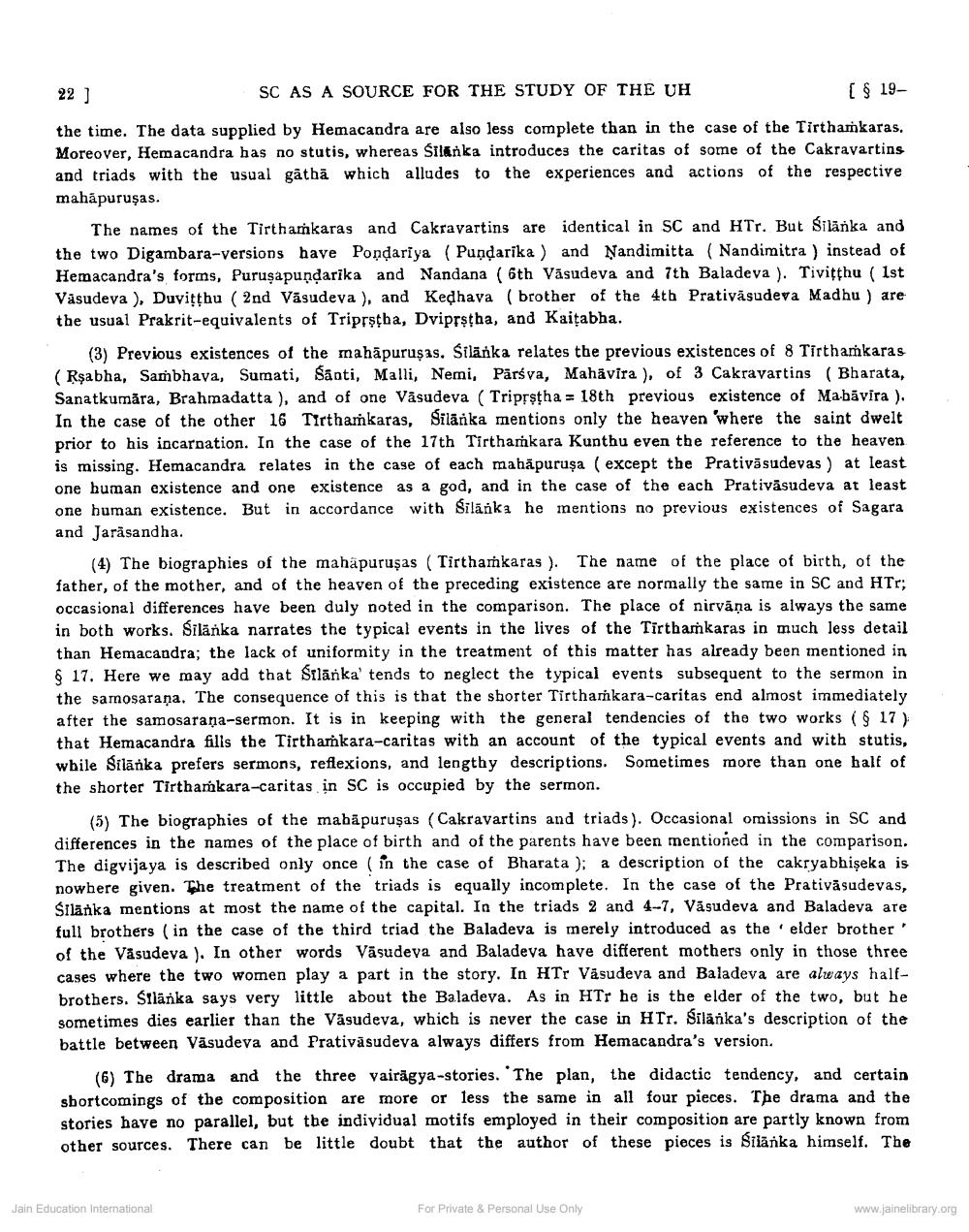________________
22 ]
SC AS A SOURCE FOR THE STUDY OF THE UH
[ $ 19
the time. The data supplied by Hemacandra are also less complete than in the case of the Tirthamkaras. Moreover, Hemacandra has no stutis, whereas Silanka introduces the caritas of some of the Cakravartins and triads with the usual gathā which alludes to the experiences and actions of the respective mahāpuruşas.
The names of the Tirthamkaras and Cakravartins are identical in SC and HTr. But Silanka and the two Digambara-versions have Pondariya (Pundarika ) and Nandimitta (Nandimitra) instead of Hemacandra's forms, Purusapundarika and Nandana (6th Väsudeva and 7th Baladeva ). Tivitthu ( 1st Vasudeva ), Duvitthu (2nd Vasudeva ), and Kedhava (brother of the 4th Prativāsudeva Madhu ) are the usual Prakrit-equivalents of Triprştha, Dviprstha, and Kaitabha.
(3) Previous existences of the mahāpurusas. Silanka relates the previous existences of 8 Tirthamkaras (Rşabha, Sambhava, Sumati, Santi, Malli, Nemi, Pārśva, Mahävira ), of 3 Cakravartins (Bharata, Sanatkumăra, Brahmadatta ), and of one Vasudeva ( Triprştha = 18th previous existence of Mabăvira ), In the case of the other 16 Tirthamkaras, Silānka mentions only the heaven 'where the saint dwelt prior to his incarnation. In the case of the 17th Tirthamkara Kunthu even the reference to the heaven is missing. Hemacandra relates in the case of each mahāpuruşa (except the Prativasudevas) at least one human existence and one existence as a god, and in the case of the each Prativasudeva at least one human existence. But in accordance with Silanka he mentions no previous existences of Sagara and Jarasandha.
(4) The biographies of the mahäpurusas (Tirthamkaras ). The name of the place of birth, of the father, of the mother, and of the heaven of the preceding existence are normally the same in SC and HTr; occasional differences have been duly noted in the comparison. The place of nirvana is always the same in both works. Silänka narrates the typical events in the lives of the Tirthamkaras in much less detail than Hemacandra; the lack of uniformity in the treatment of this matter has already been mentioned in $ 17. Here we may add that Silänka' tends to neglect the typical events subsequent to the sermon in the samosaraņa. The consequence of this is that the shorter Tirthamkara-caritas end almost immediately after the samosarana-sermon. It is in keeping with the general tendencies of the two works ($ 17) that Hemacandra fills the Tirtharkara-caritas with an account of the typical events and with stutis, wbile Silānka prefers sermons, reflexions, and lengthy descriptions. Sometimes more than one half of the shorter Tirthamkara-caritas in SC is occupied by the sermon.
(5) The biographies of the mabāpuruşas (Cakravartins and triads). Occasional omissions in SC and differences in the names of the place of birth and of the parents have been mentioned in the comparison. The digvijaya is described only once ( in the case of Bharata ); a description of the cakryabhiseka is nowhere given. The treatment of the triads is equally incomplete. In the case of the Prativasudevas, Silänka mentions at most the name of the capital. In the triads 2 and 4-7, Väsudeva and Baladeva are full brothers (in the case of the third triad the Baladeva is merely introduced as the elder brother' of the Vasudeva ). In other words Väsudeva and Baladeva have different mothers only in those three cases where the two women play a part in the story. In HTr Vasudeva and Baladeva are always halfbrothers. Sllanka says very little about the Baladeva. As in HTr he is the elder of the two, but he sometimes dies earlier than the Väsudeva, which is never the case in HTr. Silänka's description of the battle between Väsudeva and Prativasudeva always differs from Hemacandra's version.
(6) The drama and the three vairāgya-stories. The plan, the didactic tendency, and certain sbortcomings of the composition are more or less the same in all four pieces. The drama and the stories have no parallel, but the individual motifs employed in their composition are partly known from other sources. There can be little doubt that the author of these pieces is Silanka himself. The
Jain Education International
For Private & Personal Use Only
www.jainelibrary.org




